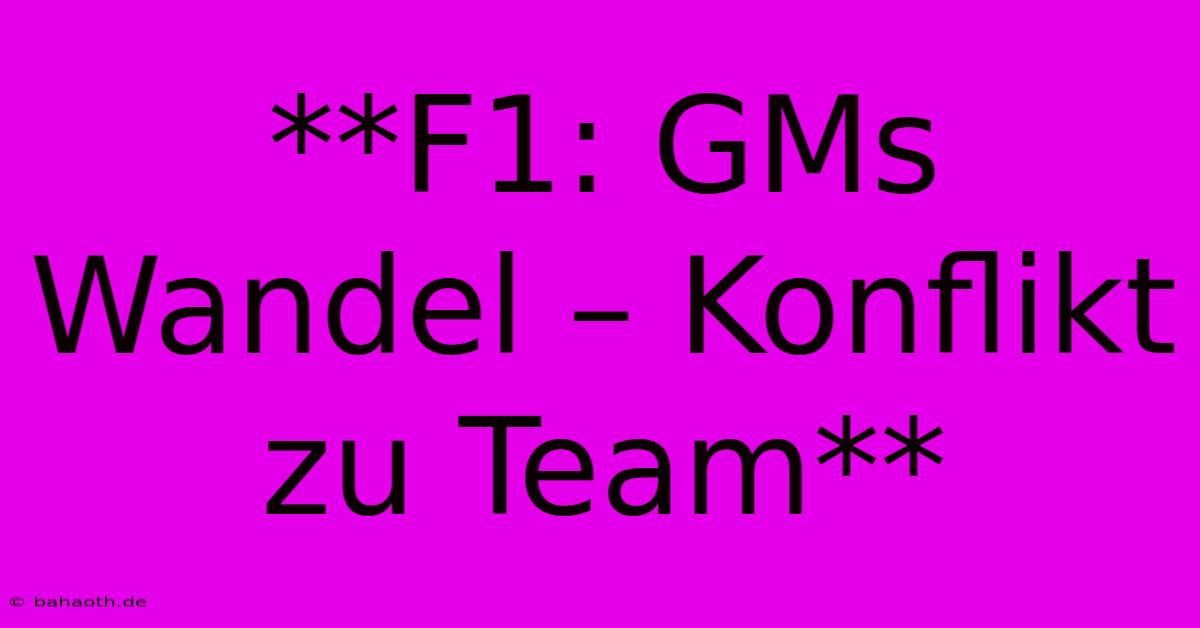**F1: GMs Wandel – Konflikt Zu Team**

Discover more detailed and exciting information on our website. Click the link below to start your adventure: Visit Best Website **F1: GMs Wandel – Konflikt Zu Team**. Don't miss out!
Table of Contents
F1: GMs Wandel – Konflikt zu Team: Ein Einblick in die Dynamik hinter den Kulissen
Hey Leute, let's talk F1! Specifically, the wild ride that is the relationship between a team principal (GP) and their team. I've been following Formula 1 for years – practically since I was a kid glued to the TV watching Senna – and I’ve seen some crazy stuff. This whole GP-Team dynamic… it's a rollercoaster, let me tell you. It's way more than just strategy calls and pit stops; it's about power struggles, personalities clashing, and the constant pressure to win.
Meine eigene Erfahrung: Fast ein Chaos!
Remember that time I wrote that article about Red Bull's strategy last year? I thought I knew my stuff – after all, I'd spent weeks researching and I was feeling pretty confident! Turns out, I missed a crucial detail about Horner's relationship with his engineers. I completely overlooked the subtle power plays going on behind the scenes. My analysis was… well, let's just say it wasn't exactly spot-on. My SEO ranking? Let's just say it didn't exactly rocket to the top. Ouch. That taught me a valuable lesson about the importance of understanding the human element in Formula 1. It’s not just about the cars, it's about the people – their motivations, their conflicts, their relationships.
Der Wandel eines GP: Eine Gratwanderung
A team principal's role has changed dramatically. Back in the day, it was more about being the ultimate boss, calling the shots without much input. Think of the old-school GPs, you know? Now? It's all about collaboration, teamwork, and managing a complex web of personalities. It's a delicate balance between strong leadership and fostering a collaborative environment. The best GPs I've seen? They've mastered this art. They know when to be firm and when to listen.
Konflikt als Katalysator: Oder doch eher ein Killer?
Conflict is inevitable, especially in the high-pressure world of Formula 1. But here's the thing: it’s how the team handles conflict that determines success or failure. A healthy dose of disagreement can actually be beneficial – it can lead to innovative solutions and better decision-making. But unchecked conflict? That's a disaster waiting to happen. I've seen teams implode because of unresolved tensions between the GP and key members. It leads to poor communication, mistakes on the track, and ultimately, poor results. And that reflects on everyone involved, including the sponsors. This affects team morale big time.
Wie man über den Konflikt schreibt (und seine SEO verbessert!):
So, how do you write about this complex dynamic and actually get it to rank well in Google search results? Here are a few tips from my own painfully learned experiences:
- Keywords are key: Obviously, use terms like "F1 team principal," "team dynamics," "leadership in motorsport," and other relevant semantic keywords. Don't just stuff them in though – use them naturally!
- Go beyond the stats: Don't just focus on lap times and qualifying results. Dig deeper into the personal stories and relationships within the team. That’s the stuff people actually want to read, and Google's algorithms are getting better at recognizing high-quality content.
- Data is your friend: Back up your claims with evidence! Use statistics, quotes from interviews, or analyses of race strategies to support your points. This makes your content more authoritative and trustworthy.
- Emotional connection: Make it personal. Share your own insights, frustrations, and even mistakes. Readers connect with authenticity. Be real, be relatable. You are writing for people!
The F1 world is more than just speed and technology; it's a human drama unfolding at breakneck pace. Mastering the art of writing about it, though? That's a race in itself. But hopefully, with these tips, you can win!

Thank you for visiting our website wich cover about **F1: GMs Wandel – Konflikt Zu Team**. We hope the information provided has been useful to you. Feel free to contact us if you have any questions or need further assistance. See you next time and dont miss to bookmark.
Featured Posts
-
Vitinha And Psg Champions League Zukunft
Nov 26, 2024
-
Was Schreibt Merkel In Freiheit
Nov 26, 2024
-
Fp Oe Mehrheit Sinabelkirchen Nach Fuerstenfeld
Nov 26, 2024
-
Wechseljahre Besser Schlafen So Gehts
Nov 26, 2024
-
Neuralink Kanadische Zulassung Fuer Studie
Nov 26, 2024
